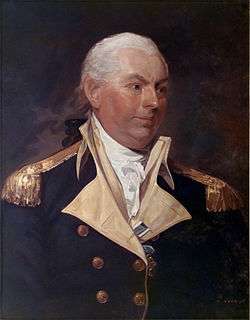John Barry (naval officer)
| John Barry | |
|---|---|
|
An 1801 Gilbert Stuart portrait of Barry. | |
| Born |
March 25, 1745 Tacumshane, County Wexford, Ireland |
| Died |
September 13, 1803 (aged 58) Philadelphia, Pennsylvania, U.S. |
| Buried at |
St. Mary's Roman Catholic Church Philadelphia, Pennsylvania, U.S. |
| Allegiance |
|
| Service/branch |
|
| Years of service | 1775–1783, 1797–1803 |
| Rank |
|
| Battles/wars |
|
John Barry (March 25, 1745 – September 13, 1803) was an officer in the Continental Navy during the American Revolutionary War and later in the United States Navy. He came to be widely credited as "The Father of the American Navy" (and shares that moniker with John Paul Jones) and was appointed a captain in the Continental Navy on December 7, 1775.[1] He was the first captain placed in command of a US warship commissioned for service under the Continental flag.[2]
After the war, he became America's first commissioned naval officer, at the rank of commodore, receiving his commission from President George Washington in 1797.
Early life and education
Barry was born on March 25, 1745, in Tacumshane, County Wexford, Ireland. Barry's family was driven from their ancestral home by the British.
Career
Barry received his first captain's commission in the Continental Navy on March 14, 1776, signed by John Hancock, president of the Continental Congress. Barry was a religious man and began each day at sea with a reading from the Bible. He had great regard for his crew and their well being and always made sure they were properly provided for while at sea.[3]
During his naval career Barry commanded United States Ships Delaware, Lexington, Raleigh, and Alliance.
Command of Delaware
In 1777 Barry commanded the ship USS Delaware, a brig sailing under a letter of marque capturing English vessels in the Delaware River.[4]
Command of Raleigh
In 1778 Barry assumed command of the USS Raleigh, capturing three prizes before being run aground in action on September 27, 1778. Her crew scuttled her, but she was raised by the British who refloated her for further use in the Royal Navy.[5]
Command of Lexington
Captain Barry was given command of USS Lexington, of 14 guns, on December 7, 1775. It was the first commission issued by the Continental Congress.[6] The Lexington sailed March 31, 1776. On April 7, 1776, off the Capes of Virginia, he fell in with the Edward, tender to the British man-of-war HMS Liverpool, and after a desperate fight of one hour and twenty minutes captured her and brought her into Philadelphia.
On June 28, Pennsylvania's brig Nancy arrived in the area with 386 barrels of powder in her hold and ran aground while attempting to elude British blockader Kingfisher. Barry ordered the precious powder rowed ashore during the night leaving only 100 barrels in Nancy at dawn. A delayed action fuse was left inside the brig, which exploded the powder just as a boatload of British seamen boarded Nancy.[7] This engagement became known as the Battle of Turtle Gut Inlet.[8]
Barry continued in command of Lexington until October 18, 1776, and captured several private armed vessels during that time.
Barry authored a signal book published in 1780 to improve communications at sea among vessels traveling in formation.[9]
Command of Alliance
He and his crew of the USS Alliance fought and won the final naval battle of the American Revolution off the coast of Cape Canaveral on March 10, 1783. He was seriously wounded on May 29, 1781, while in command of Alliance during her capture of HMS Atalanta and Trepassey. Barry was successful in suppressing three mutinies during his career as an officer in the Continental Navy.[10]
John Barry was once offered 100,000 British pounds and command of any frigate in the entire British Navy if he would desert the American Navy. Outraged at the offer, Captain Barry responded that not all the money in the British treasury or command of its entire fleet could tempt him to desert his adopted country.[11]
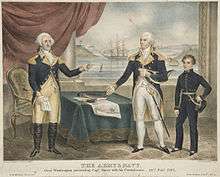
Commodore commission
On February 22, 1797, he was issued Commission Number 1 by President George Washington, backdated to June 4, 1794. His title was thereafter "commodore." He is recognized as not only the first American commissioned naval officer but also as its first flag officer.[12]
Command of United States
Appointed senior captain upon the establishment of the U.S. Navy, he commanded the frigate United States in the Quasi-War with France. This ship transported commissioners William Richardson Davie and Oliver Ellsworth to France to negotiate a new Franco-American alliance.
Barry's last day of active duty was March 6, 1801, when he brought the USS United States into port, but he remained head of the Navy until his death on September 12, 1803, from asthma. Barry died childless.[13]
Later life and death
Barry died at Strawberry Hill, in present-day Philadelphia on September 13, 1803, and was buried in the graveyard of Old St. Mary's Roman Catholic Church in Center City, Philadelphia.[14]
Personal life
On October 24, 1768, Barry married Mary Cleary, who died in 1774. On July 7, 1777, he married Sarah Austin, daughter of Samuel Austin and Sarah Keen of New Jersey. Barry had no children, but he helped raise Patrick and Michael Hayes, children of his sister, Eleanor, and her husband, Thomas Hayes, who both died in the 1780s.
Commemorations
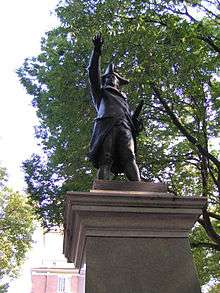
- The US Revenue Cutter Commodore Barry, captured in the War of 1812 off Maine
- Commodore Barry Park in Brooklyn, New York. It is the oldest park in the borough. It was renamed for Commodore Barry in 1951, due to its location next to the Brooklyn Navy Yard that Barry helped found.
- Four U.S. Navy ships
- USS Barry (DD-2) (1902–1920)
- USS Barry (DD-248) (1921–1945)
- USS Barry (DD-933) (1956–1983)
- USS Barry (DDG-52) (1992– )
- In World War II, the United States liberty ship SS John Barry was named in his honor.
- There is a large portrait of Commodore Barry at the Rhode Island State House in Providence; and Title 16 of the Rhode Island Statutes (§ 16-20-3 – Days of special observance) requires observing September 13 as Commodore John Barry Day.
- John Barry Hall at the United States Merchant Marine Academy
- Commodore Barry Bridge, which crosses the Delaware River from Chester, Pennsylvania to Bridgeport, New Jersey.
- John Barry Hall at Villanova University
- Commodore Barry Club (Philadelphia Irish Center) Emlen St & Carpenter Lane, Mt Airy, Phila Pennsylvania
- Barry Township, Schuylkill County, Pennsylvania
- Commodore John Barry Elementary School in Philadelphia, Pennsylvania
- Commodore John Barry Elementary School in Chicago, Illinois
- Commodore John Barry Division of Ancient Order of Hibernians, Annapolis, Maryland
- John Barry Bar, Grand Hyatt Muscat, Muscat, Oman
- September 13, Commodore John Barry Day in New Jersey public schools
- Commodore John Barry Memorial Plaque at Staten Island Borough Hall
- A new plaque with a cannon was dedicated on March 10, 2007, in Port Canaveral.
- A plaque stands in the city of Boston at Boston Common.
- A plaque commemorating Barry and his crew of the Alliance for the final naval battle of the American Revolution is located at Jetty Park in Cape Canaveral, Florida.
- A stone plaque commemorating his grave site is located at Old St. Mary's Church in Philadelphia, PA.
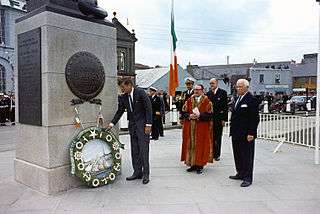
- A 6 ft. bronze statue of Commodore John Barry stands in Franklin Square (between I and K sts. on 14th st. N.W.) in Washington, D.C.
- An entrance to the United States Naval Academy, from Downtown Annapolis to the Visitor's Center, commemorates Commodore John Barry.
- A large statue of Barry stands directly in front of the formal entrance to Independence Hall in Philadelphia, PA.
- A statue of Barry overlooks the Crescent Quay in Wexford town in Ireland. It was a gift to the town from the United States and was delivered by a United States Navy Destroyer USS John R. Pierce (DD-753). The statue was unveiled in 1956, and each year a parade and wreath-laying ceremony takes place at the statue to celebrate "Barry Day", commemorated by the Irish Naval Service and the Minister for Defence.
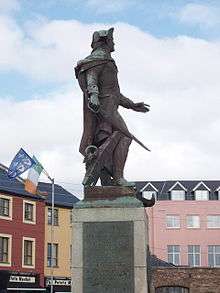
Barry and John Paul Jones on a U.S. postage stamp |
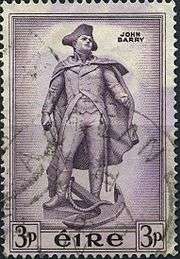 Barry on an Irish postage stamp |
See also
- Bibliography of early American naval history
- Commodore Stephen Decatur
- Commodore John Hazelwood
- Irish military diaspora
- William Brown (admiral), "Father of the Argentine Navy"
- List of people on stamps of Ireland
References
![]() This article incorporates public domain material from the Naval History & Heritage Command document "Captain John Barry".
This article incorporates public domain material from the Naval History & Heritage Command document "Captain John Barry".
Footnotes
- ↑ Williams, 2008 p. 5
- ↑ Meany, 1911 p. 1
- ↑ Williams, 2008 p. 73
- ↑ Meany, 1911 p. 22
- ↑ Ignatius, Griffin, 1897 pp. 42–44
- ↑ Williams, 2008 p. 72
- ↑ "Lexington". Dictionary of American Naval Fighting Ships. Navy Department, Naval History & Heritage Command.
- ↑ "The Battle of Turtle Gut Inlet". Wildwood Crest Historical Society.
- ↑ Woods, D. & Sterling, C. Signaling and communicating at sea. Arno Press, 1980. p. 195
- ↑ "Alliance". Dictionary of American Naval Fighting Ships. Navy Department, Naval History & Heritage Command.
- ↑ The American Irish Blog
- ↑ specifically issued by a Joint Congressional Resolution and proclaimed by President George W. Bush on December 22, 2006.
- ↑ Meany, 1911 pp. 56–57
- ↑ John Barry at Find a Grave
Bibliography
- Clark, William Bell (1938). Gallant John Barry 1745 1803 The Story Of A Naval Hero Of Two Wars.
The Macmillan Company, New York. p. 554. Url - Fink, Leo Gregory (1962). Barry or Jones, "Father of the United States Navy"; Historical Reconnaissance.
Jefferies & Manz, Inc, Philadelphia. p. 138. Url - Ignatius, Martin; Griffin, Joseph (1897). The history of Commodore John Barry.
Published by the Author, Philadelphia. p. 261. Url - —— (1903). Commodore John Barry: "the father of the American navy".
Published by the Author, Philadelphia. p. 424. Url - McGrath, Tim (2010). John Barry: An American Hero in the Age of Sail.
AuthorHouse, IN. p. 704. ISBN 978-1-59416-104-9. Url - Meany, William Barry (1911). Commodore John Barry, the father of the American navy:
a survey of extraordinary episodes in his naval career.
Harper & brothers, New York, London. p. 74. Url - Williams, Thomas (2008). America's First Flag Officer: Father of the American Navy.
AuthorHouse, IN. p. 260. ISBN 978-1-4343-8654-0. Url
Further reading
- Fowler, William M. (1976). Rebels under sail: the American Navy during the Revolution.
Charles Scribner and Sons, New York. p. 356. ISBN 978-0-684-14583-9. Url
External links
| Wikimedia Commons has media related to John Barry. |
- Webb, Alfred (1878). "
 Barry, John". A Compendium of Irish Biography. Dublin: M. H. Gill & son. Wikisource
Barry, John". A Compendium of Irish Biography. Dublin: M. H. Gill & son. Wikisource - Father of the American Navy
- Portraits of Barry
- Barry-Hayes Collection, papers at Independence Seaport Museum, Philadelphia, Pennsylvania, digitized by Villanova University's Digital Library, Villanova, Pennsylvania.
